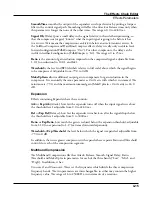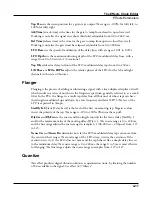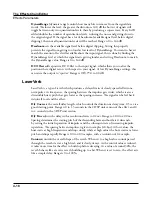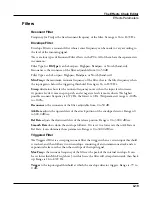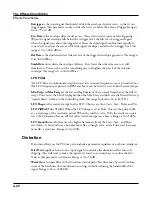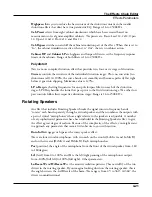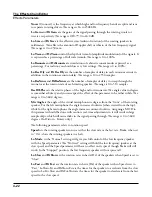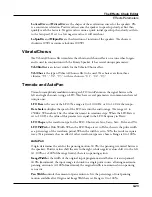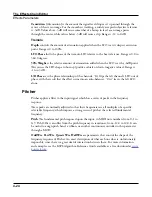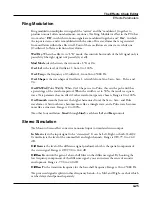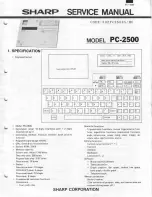
The Effects Chain Editor
Effects Parameters
4-10
XCouple
(Cross Couple). In stereo effects, this controls how much of any signal being
fed back is going to the channel opposite to the one where it first appeared. At 100%, all
feedback from signals at the left input goes to the right channel and vice versa, causing a
“spreading” or in the case of delay lines, a “ping-pong” effect. At 0%, fed-back signals stay
with the channel they came in on.
A->B cfg
(configuration). In combination effects that contain two (or more) components,
the order in which the signal passes through the two components can be changed with this
parameter. Combination effects are usually named with a “->”, as in 484 “Flange->Shaper.”
For example, 484 “Flange->Shaper” can be configured so the signal passes through the
flanger first and then the shaper, or through the shaper first and then the flanger. The cfg
parameter determines the configuration, and its value is context-sensitive—in this example,
the choices would be “Fl->Shp” and “Shp->Fl.”
A/Dry->B
is also found in many combination effects, and controls the amount of signal
that will pass dry (unprocessed) through the first component into the second component.
Different combination effects use different variations on this parameter, depending on the
context. The range is 0 to 100%.
Reverbs
Room Type
changes the configuration of the effect to simulate a wide array of room types
and sizes including booths, small rooms, chambers, halls and large spaces. Because this
parameter changes the structure of the reverb effect, you need to be careful when assigning it
a MOD— changing it in real time while signal is passing through it is likely to cause audible
artifacts. Room types in different effects with similar names do not necessarily sound the
same.
Rvrb Time
is the RT60—the time it takes for the reverb to decay to 60 dB below its initial
level—in seconds. It is accurate assuming that several other parameters (HF Damping, Diff
Scale, Size Scale, and Density) are at their nominal levels. It is adjustable up to “Inf”, which
creates an infinitely-sustaining reverb.
LateRvbTim
adjusts the basic decay time of the late portion of the reverb after diffusion.
L Pre Dly and R Pre Dly (Pre-Delay) is the time between the start of a sound and the output
of the first reverb reflections from that sound. Longer pre-delays can help make larger spaces
sound more realistic. Longer times can also help improve the clarity of a mix by separating
the reverb signal from the dry signal, so the dry signal is not obscured. You can set a separate
time for the left and right reverb signals using L Pre Dly and R Pre Dly.
EarRef Lvl
adjusts the mix level of the early-reflection portion of effects which offer early
reflections.
Late Lvl
adjusts the mix level of the late-reverb portion of effects which offer early
reflections.
Summary of Contents for Flash Play PC4
Page 1: ... It s the sound Part Number 910587 002 Rev B ...
Page 9: ... ix MIDI Implementation A 1 Specifications B 1 Index I 1 ...
Page 289: ... 8 40 ...
Page 328: ... 10 7 ...




















